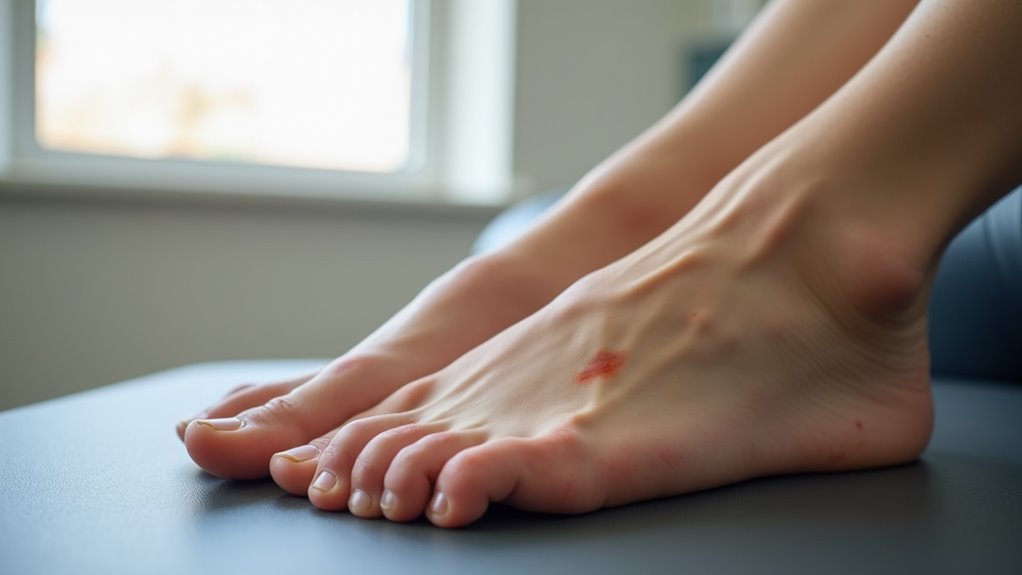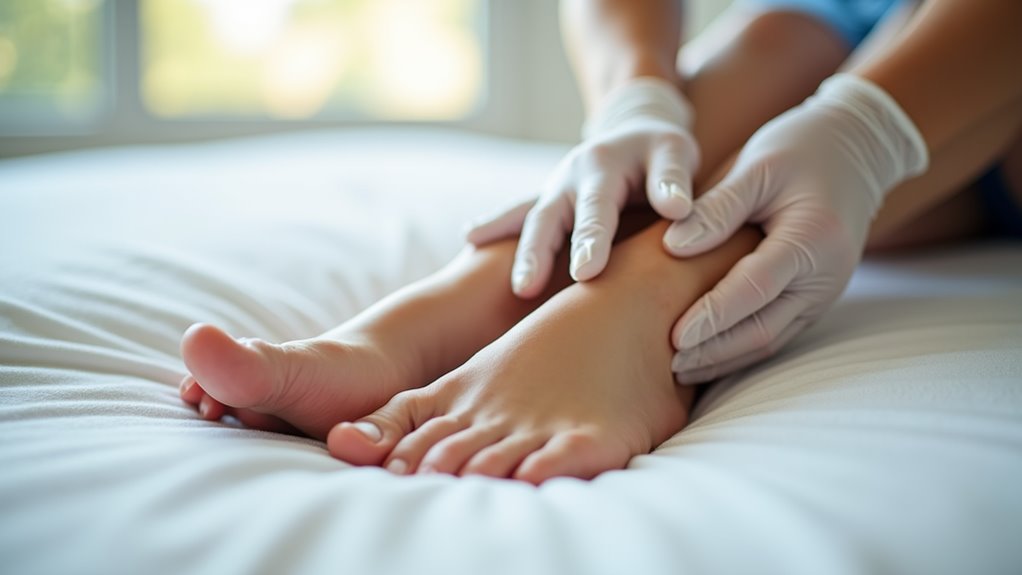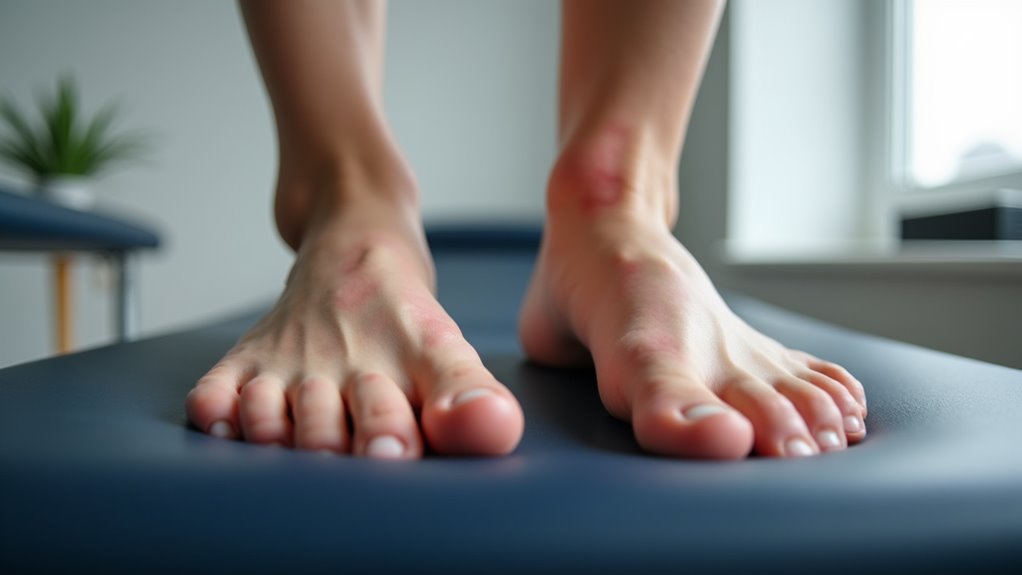There may be products. Products are independently selected by our editors. We may earn an affiliate commission from the links with no charge to you, example: as Amazon Affiliate.
Your feet tell a million stories about your health, but you’ve probably been ignoring their desperate signals. When you understand what to look for, these hard-working appendages can reveal early warnings of diabetes, heart disease, and circulatory problems long before other symptoms emerge. While basic issues like calluses and dry skin might seem trivial, they can mask more serious underlying conditions that need attention. By learning to interpret these signs now, you’ll discover critical insights about your overall wellness that could help you prevent major health complications down the road.
Key Takeaways
- Non-healing sores, cold feet, and leg cramping during walks are critical warning signs of potential circulation problems.
- Daily foot inspections help detect early signs of problems like bunions, hammertoes, and fungal infections.
- Changes in foot sensation, color, or frequent tripping require immediate medical attention to prevent serious complications.
- Proper foot hygiene, including thorough drying between toes and regular moisturizing, prevents common foot problems.
- Diabetic patients should monitor burning sensations and skin changes carefully, as they face higher risks of foot complications.
Common Foot Problems Today

Millions of people experience foot problems that can significantly impact their daily lives.
You’ll likely encounter common conditions like bunions, which create painful deformities at your big toe’s base, or plantar fasciitis, causing intense heel pain, especially in the morning.
Hammertoes and fallen arches can also develop, leading to chronic discomfort and mobility issues.
Your genetics, age, and weight play crucial roles in developing these conditions.
If you’re wearing tight, pointy shoes, you’re increasing your risk of bunions and hammertoes.
Poor foot mechanics and inherited biomechanical issues can worsen these problems over time.
Watch for warning signs like persistent pain, swelling, or visible deformities.
When these symptoms appear, they often indicate an underlying condition that requires attention and proper treatment.
Using posture support heels can help alleviate discomfort and promote better foot alignment throughout the day.
Early Warning Signs Matter
Have you ever noticed how your feet can reveal crucial information about your overall health? Your feet serve as early warning systems for serious conditions like heart problems, circulatory issues, and diabetes.
Watch for non-healing sores, cold feet, or slower toenail growth, as these can signal peripheral arterial disease. If you’re experiencing leg cramping during walks or notice swelling in your ankles, it’s time to check your circulation.
Don’t ignore signs like frequent tripping or difficulty lifting your foot, as these may indicate foot drop. For diabetics, pay special attention to burning sensations, changes in skin color, or numbness in your feet.
You’ll also want to monitor how quickly wounds heal and whether you’re losing hair on your toes or legs, as these symptoms warrant immediate medical attention.
Daily Foot Care Essentials

Now that you’re aware of the warning signs, maintaining proper foot health requires a consistent daily care routine.
Your feet need daily washing with warm water and mild soap, paying special attention to the spaces between your toes. Remember to dry them thoroughly to prevent fungal growth.
Keep your feet moisturized, focusing on dry areas like heels, but avoid applying lotion between toes.
Choose breathable footwear and moisture-wicking socks, changing them daily to prevent odor and infections. Make it a habit to rotate your shoes, allowing them to air out between uses.
Don’t forget to inspect your feet daily for any changes, trim toenails straight across, and use foot powder when needed.
Regular exfoliation and proper orthotic support can help maintain optimal foot health.
Treating Fungal Infections Effectively
Three key approaches form the foundation of effective fungal infection treatment: medical interventions, home remedies, and preventive measures.
You’ll find topical antifungal products containing ingredients like clotrimazole or terbinafine most effective when applied twice daily for 2-4 weeks.
If you prefer natural solutions, try tea tree oil mixed with coconut oil or crushed garlic applied to affected areas.
To prevent recurrence, you’ll need to maintain proper foot hygiene.
Keep your feet dry, wear breathable footwear, and use talcum powder before putting on socks.
Don’t forget to wear protective footwear in public areas.
If home treatments aren’t working, don’t hesitate to seek medical help – your doctor may prescribe oral antifungals for severe cases.
Managing Chronic Foot Pain
You’ll need a comprehensive approach to manage chronic foot pain, starting with identifying the root cause through proper medical evaluation and understanding your daily pain patterns.
Once you know what’s triggering your discomfort, you can implement appropriate lifestyle changes like wearing supportive footwear, maintaining a healthy weight, and following a stretching routine.
Your long-term success depends on combining these daily management techniques with professional treatments such as physical therapy, medical acupuncture, or specialized injections when needed.
When selecting footwear, consider comfort-focused heels that provide proper support while maintaining style.
Daily Pain Management Techniques
Managing chronic foot pain requires a comprehensive approach that combines immediate relief measures with long-term care strategies. You can start by applying ice packs to reduce swelling and elevating your feet above heart level when resting.
For quick relief, try over-the-counter pain medications or soak your feet in warm water with Epsom salts.
Daily stretching exercises are crucial for preventing stiffness. Focus on heel cord and calf stretches, and consider pool exercises to maintain activity without putting pressure on your feet.
Don’t forget to wear proper footwear and use custom orthotics if needed. If you’re dealing with persistent pain, you’ll want to make lifestyle adjustments like maintaining a healthy weight and avoiding high heels.
For severe cases, consult a podiatrist to discuss treatment options like steroid injections.
Finding Underlying Pain Causes
Chronic foot pain often stems from complex underlying conditions that require thorough investigation. You’ll need various diagnostic tests to pinpoint the root cause, as multiple factors can contribute to your discomfort.
From inherited foot structures to chronic diseases like diabetes, the sources of pain aren’t always obvious. Your doctor may start with X-rays to check for bone-related issues, then progress to MRI or ultrasound if soft tissue damage is suspected.
Don’t overlook common culprits like bunions, arthritis, or bone spurs, which frequently cause persistent pain. If you’re experiencing ongoing discomfort, poor footwear choices or repetitive stress from daily activities might be aggravating your condition.
Long-Term Treatment Options
When dealing with persistent foot pain, a comprehensive treatment approach often yields the best results.
You’ll want to combine daily self-care practices with professional medical interventions to manage your symptoms effectively. While over-the-counter medications and ice therapy can provide immediate relief, long-term solutions require a more strategic approach.
- Consider custom orthotics to properly align your feet and reduce pressure points.
- Commit to regular physical therapy sessions to strengthen foot muscles.
- Work with your doctor to explore regenerative medicine options.
- Maintain a consistent stretching routine focused on heel and arch flexibility.
If conservative treatments don’t provide relief, your doctor might recommend more advanced interventions like steroid injections or surgical options.
Remember to wear supportive footwear and modify activities that trigger pain while your treatment plan takes effect.
Natural Remedies for Foot Health
You’ll find remarkable relief for your feet by incorporating essential oils like tea tree and lavender into your foot care routine, as they naturally combat fungi and promote relaxation.
A warm salt bath with Epsom salts can reduce inflammation while drawing out toxins from your tired feet.
Tea tree oil’s powerful antifungal properties make it particularly effective when added to foot soaks or applied directly to problem areas.
Essential Oils for Relief
For those seeking natural relief from foot discomfort, essential oils offer a powerful and time-tested solution. When properly diluted with carrier oils, these natural compounds can effectively address various foot concerns while promoting overall wellness through the feet’s absorption points.
- Eucalyptus and lemongrass oils target muscle pain and soreness, especially when massaged into specific pressure points.
- Tea tree oil combats fungal issues around toenails, while juniper berry helps detoxify and reduce aches.
- Lavender oil soothes tired feet before bedtime, enhancing sleep quality.
- Essential oils absorb quickly through the feet’s large pores, making them ideal for reflexology treatments.
Remember to cover your feet with socks after application to maximize absorption and minimize odors.
While these oils provide natural relief, persistent foot pain should prompt a healthcare consultation.
Salt Bath Benefits
Salt baths offer a time-tested, therapeutic approach to maintaining foot health and relieving common ailments. When you add Epsom salt to warm water, you’ll unlock numerous benefits for your feet, from pain relief to improved circulation. The magnesium content helps reduce inflammation and muscle cramps, while the warm water promotes better blood flow through vasodilation.
| Benefit | How It Works |
|---|---|
| Pain Relief | Magnesium absorption reduces inflammation and muscle tension |
| Skin Care | Softens skin and aids in dead cell removal |
| Circulation | Warm water promotes blood flow and reduces swelling |
| Detoxification | Salt draws out impurities through the skin |
Regular foot soaks can prevent bacterial and fungal infections while promoting overall foot hygiene. If you have diabetes or circulation issues, consult your healthcare provider before starting a salt bath routine.
Tea Tree Applications
Tea tree oil stands as a powerful natural remedy for maintaining optimal foot health, offering both therapeutic and preventative benefits.
You’ll find this versatile oil particularly effective when combined with Epsom salt in a 15-20 minute foot soak, followed by proper moisturization to lock in hydration.
Before using tea tree oil, always dilute it with a carrier oil like coconut oil to prevent skin irritation.
For best results, you’ll want to be consistent with your treatment routine, especially when addressing issues like nail fungus.
- Creates a soothing foot soak that cleanses and calms irritated skin
- Helps combat fungal infections and athlete’s foot with regular use
- Works effectively in combination with standard medicated treatments
- Can be used in moisturizing foot oils for overnight treatment with aloe socks
Best Practices for Prevention

Maintaining proper foot health requires a comprehensive approach that combines daily care routines with preventive measures.
You’ll need to inspect your feet daily for any changes, wash them thoroughly in lukewarm water, and keep them moisturized while avoiding the areas between your toes.
Choose well-fitted shoes with proper arch support, and don’t forget to protect your feet from sun exposure.
Make prevention a priority by alternating your shoes daily and keeping them clean.
Before exercising, stretch properly and consider low-impact activities like cycling.
If you notice any warning signs such as changes in sensation or appearance, seek medical attention promptly.
For those with diabetes, regular self-checks are essential.
Remember to cut your toenails straight across and never walk barefoot in public areas.
Professional Treatment Options
Professional foot care encompasses a wide range of treatment options that can address various conditions and symptoms. When you’re experiencing foot problems, your healthcare provider might recommend conservative treatments before considering surgical interventions.
Common professional treatments include:
- Custom orthotics and shoe modifications to redistribute pressure and improve comfort
- Physical therapy combined with manual treatments to enhance strength and mobility
- Therapeutic techniques like laser therapy or dry needling for pain management
- Advanced solutions such as PRP injections or surgical procedures for severe cases
The addition of arrow design navigation can help patients easily locate related treatment options and products online. Don’t hesitate to seek professional help if you’re dealing with persistent foot pain.
Many conditions respond well to early intervention, and your provider can develop a personalized treatment plan using various approaches to address your specific needs.
Emergency Foot Care Signs

While preventive care and professional treatments help maintain foot health, recognizing emergency warning signs can prevent serious complications.
You’ll need to watch for changes in your foot’s appearance, including redness, swelling, or unusual temperature variations. Pay attention to new blisters, cuts, or wounds, especially if you can’t feel them.
Don’t ignore pain or throbbing in your feet, and be alert to open sores that won’t heal. If you notice signs of infection like pus, foul odor, or leaking fluid, it’s crucial to act quickly.
For diabetic patients, prompt treatment is vital, as delayed care increases amputation risk by up to 20 times. When you spot these warning signs, contact your healthcare provider immediately, keep weight off the affected foot, and seek emergency care if you suspect sepsis.
Using trusted foot products recommended by podiatrists can help prevent many common foot emergencies before they start.
Long-Term Foot Health Strategies
You’ll need to establish a robust daily foot care routine that includes thorough washing, moisturizing, and regular inspections to maintain long-term foot health.
Making smart choices about footwear, exercise, and prompt medical attention when issues arise can prevent many common foot problems from developing into serious conditions.
Daily Care Routine Essentials
Maintaining a consistent daily foot care routine is essential for preventing problems and promoting long-term foot health. You’ll need to focus on proper washing, drying, and moisturizing techniques while regularly inspecting your feet for potential issues.
- Wash your feet with warm water and mild soap, paying special attention to between your toes, then pat them completely dry.
- Apply moisturizer to dry areas and heels, but avoid putting it between toes where fungus can grow.
- Trim toenails straight across to prevent ingrowth, and never cut them too short.
- Rotate your shoes daily and wear breathable socks made from cotton or wool.
Remember to check your feet daily for any changes in color, texture, or signs of irritation. Use a gentle exfoliating tool like a pumice stone to remove dead skin and improve circulation.
Prevention Through Smart Choices
Taking proactive steps toward long-term foot health can prevent many common problems before they start. You’ll significantly reduce your risk of complications by making smart daily choices about footwear, exercise, and lifestyle habits. Don’t overlook the importance of alternating your shoes and maintaining proper foot hygiene.
| Smart Choice | Benefits |
|---|---|
| Quality shoes that fit well | Prevents blisters, corns, and joint strain |
| Regular exercise variety | Improves circulation and reduces repetitive stress |
| Weight management | Decreases pressure on feet and ankles |
| Daily foot inspections | Catches problems early before complications |
| Proper moisture control | Prevents fungal growth and skin breakdown |
Remember to give your feet adequate rest between workouts and stay alert to warning signs like numbness or persistent pain. Early intervention can make the difference between minor issues and major complications.
Building Healthy Foot Habits
Lifelong foot health begins with consistent daily habits that protect and nurture your feet.
You’ll need to establish a routine that includes regular inspection and proper hygiene while staying alert to potential problems.
- Wash your feet thoroughly each day, paying special attention to drying between your toes to prevent fungal growth.
- Apply moisturizer after washing, but avoid putting it between your toes where excess moisture can cause problems.
- Rotate your shoes daily to allow them to dry completely, and always wear moisture-wicking socks.
- Check your feet every evening for changes in color, texture, or sensation.
Don’t ignore early warning signs – they’re your body’s way of alerting you to potential issues.
When in doubt, consult a podiatrist rather than attempting self-treatment with over-the-counter remedies.
Conclusion
Your feet are telling a story you can’t afford to ignore. When they’re feeling under the weather, it’s time to step up your care routine. While some discomfort may be temporary, chronic issues could signal it’s time to seek professional guidance. By staying ahead of potential troubles and maintaining proper foot care, you’ll keep dancing through life with confidence and comfort.
